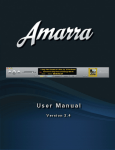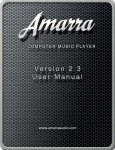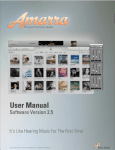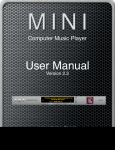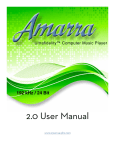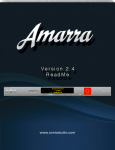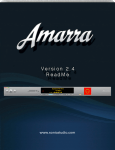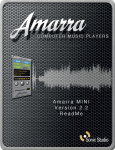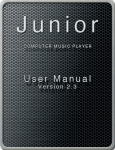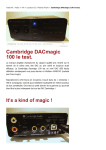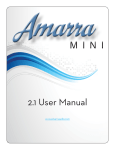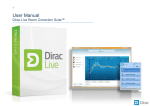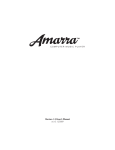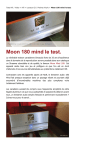Download Amarra_243_User_Manu..
Transcript
www.sonicstudio.com Amarra 2.4 User Manual Amarra Table Of Contents About This Manual 1.0.0 Thank you! 2.0.0 Amarra Minimum System Requirements: 3.0.0 Installing Amarra Software: 3.1.0 Easy Setup Script 3.2.0 Uninstalling Amarra Software 4.0.0 Evaluating and Activating Amarra : 4.1.0 Evaluating Amarra : 4.2.0 Activating Amarra : 4.3.0 Activating Amarra After your Evaluation Period Expires 4.4.0 License Control Panel 4.5.0 Important Information : Amarra Activation Guide 5.0.0 Launching and Using Amarra 5.1.0 Amarra Application Menus : 5.1.1 The Amarra Menu: 5.1.2 The File Menu: 5.1.3 The . Playlist...Menu: 5.1.4 The Desk Menu: 5.1.5 The Windows Menu: 5.1.6 The Help Menu: 6. 0.0 Using Amarra and iTunes 6.1.0 Using Amarra: 6.1.1 Changing the Playback position 6.2.0 Amarra EQ 6.3.0 Amarra Preferences 6.3.1 Additional Sonic Hardware Preference Settings 6.4.0 Using Amarra with Remote Control 6.4.1 Using Apple Remote and your iPhone / iPad 6.4.2 Using Amarra with Infrared Remote Control 6.4.3 Using your Airport Express 6.5.0 Amarra and FLAC 6.5.1 Converting FLAC to AIFF 6.6.0 Amarra Background Manager 6.7.0 Amarra Playlist Mode 6.7.1 Adding Tracks to a Playlist : 6.7.2 Reordering Tracks in Playlist : 6.8.0 Audio Device Preferences 7.0.0 Amarra Symphony 7.1.0 Meters Display 7.2.0 Preferences Window 7.3.0 Sonic Mastering EQ 7.4.0 Panner Window 8.0.0 Registering Your Amarra Software 9. 0.0 Troubleshooting Guide 10.0.0 Support Page #2 3 4 4 5 8 8 9 9 9 11 11 11 11 12 12 13 14 15 15 16 17 19 20 21 24 25 26 26 26 26 27 27 28 30 30 30 33 37 37 37 38 39 40 41 47 Amarra 2.4 User Manual About This Manual This manual, as well as the software described in it, is furnished under license and may only be used or copied in accordance with the terms of such license. The information in this manual is furnished for informational use only, is subject to change without notice, and should not be construed as a commitment by Sonic Studio, LLC. Sonic Studio, LLC assumes no responsibility or liability for any errors or inaccuracies that may appear in this book. Except as permitted by such license, no part of this publication may be reproduced, stored in a retrieval system, or transmitted, in any form or by any means, electronic, mechanical, recording, or otherwise, without the prior written permission of Sonic Studio, LLC. Notice of Liability The author and publisher have made every effort to ensure the accuracy of the information herein. However, the information contained in this document is provided without warranty, either express or implied. Neither the authors, Sonic Studio, LLC, nor its dealers or distributors will be held liable for any damages to be caused either directly or indirectly by the instructions contained in this book, or by the software or hardware products described herein. SONIC STUDIO, LLC MAKES NO WARRANTIES, EXPRESS OR IMPLIED, INCLUDING WITHOUT LIMITATION THE IMPLIED WARRANTIES OF MERCHANTABILITY AND FITNESS FOR A PARTICULAR PURPOSE, REGARDING THE APPLE SOFTWARE. SONIC STUDIO, LLC DOES NOT WARRANT, GUARANTEE, OR MAKE ANY REPRESENTATIONS REGARDING THE USE OR THE RESULTS OF THE USE OF THE SONIC STUDIO, LLC SOFTWARE IN TERMS OF ITS CORRECTNESS, ACCURACY, RELIABILITY, CURRENTNESS, OR OTHERWISE. THE ENTIRE RISK AS TO THE RESULTS AND PERFORMANCE OF THE SONIC STUDIO SOFTWARE IS ASSUMED BY YOU. THE EXCLUSION OF IMPLIED WARRANTIES IS NOT PERMITTED BY SOME STATES. THE ABOVE EXCLUSION MAY NOT APPLY TO YOU. IN NO EVENT WILL SONIC STUDIO, LLC, ITS DIRECTORS, OFFICERS, EMPLOYEES, OR AGENTS BE LIABLE TO YOU FOR ANY CONSEQUENTIAL, INCIDENTAL, OR INDIRECT DAMAGES (INCLUDING DAMAGES FOR LOSS OF BUSINESS PROFITS, BUSINESS INTERRUPTION, LOSS OF BUSINESS INFORMATION, AND THE LIKE) ARISING OUT OF THE USE OR INABILITY TO USE THE SONIC STUDIO SOFTWARE EVEN IF SONIC STUDIO HAS BEEN ADVISED OF THE POSSIBILITY OF SUCH DAMAGES. BECAUSE SOME STATES DO NOT ALLOW THE EXCLUSION OR LIMITATION OF LIABILITY FOR CONSEQUENTIAL OR INCIDENTAL DAMAGES, THE ABOVE LIMITATIONS MAY NOT APPLY TO YOU. Notice of Rights ©2007-2012 Sonic Studio, LLC — All rights reserved. No part of this document may be reproduced, stored in a retrieval system or transmitted in any form or by any means, without the prior written permission of the publisher. Sonic Studio, Amarra, Amarra Hifi,, Sonic Mastering EQ, Model 302, Model 303, Model Four, Model 305 and the Sonic Studio and Amarra logos are trademarks of Sonic Studio, LLC. All other company or product names are either trademarks or registered trademarks of their respective owners. Page #3 Amarra Computer Music Player User Manual 1.0.0 Thank you! Thank you for purchasing the Amarra Computer Music Player. You are about to enjoy the Ultrafidelity sound of Amarra. Designed to work with your Apple™ MacIntosh Computer and with iTunes, Amarra provides a seamless integration for high resolution music playback. Sonic Studio, LLC 330 Sir Frances Drake Blvd, Suite A San Anselmo, CA USA 94960-2552 [email protected] www.sonicstudio.com The Amarra 2.4 installer will install the following items on to your Macintosh Computer: • Amarra 2.4.3 Computer Music Player • Amarra Documentation • FLAC Component 2.0.0 Amarra Minimum System Requirements: Amarra requires the following: Computer: • Any Intel–based Mac - PPC / G5 is not supported. • RAM: 4 GB minimum, 4 or more preferred • Software: Mac OS X 10.6.x and above Amarra and iTunes • I/O: Core Audio Interface (Built-in, Optical, USB, and FireWire) The built-in Macintosh Audio (analog/optical/digital) will work with Amarra but has limited sample rate support. Please visit the Supported Hardware section of www.sonicstudio.com for more information. NOTE: A network connection is required to authorize your software. Using OS X 10.8 : Mountain Lion: When using Mountain Lion based systems you will be prevented the initial launch of the Amarra or soundBlade installer application; see example below. Please use the following procedure if you see this warning. • right-click or control+click on the Installer package • select ‘Open’ in the contextual menu that’s presented • select Open in the next window - the installer then runs Page #4 Amarra 2.4 User Manual 3.0.0 Installing Amarra Software: NOTE: Amarra 2.4 uses a licensing mechanism that will attempt to automatically update your license to version 2.4. For automatic licensing to work properly, your current Amarra folder must be named either Amarra 2.4, Amara 2.3 or MINI 2.3. If you are presented with an Activation Window, please follow the instructions for Activating Amarra in section 4.2.0 below. To install Amarra, download the software using the URL sent in your email or from www. sonicstudio.com. Locate the download of Amarra, first unzip if needed and then double-click on the Amarra_ Installer icon. Follow the on screen instructions to install your software. Welcome screen for Amarra Installer: Select Continue. Page #5 Amarra Computer Music Player User Manual Software License Agreement: Select Continue. Please Read Carefully. Select Agree to agree to the End-User Software License Agreement Amarra 2.4 User Manual Install Amarra : Click Install. (You will be prompted for your Mac password and the software will be installed.) Success! Page #7 Amarra 2.4 User Manual Select the Close button to quit the Amarra installer. • Amarra Computer Music Player is installed into the Applications folder. It is installed here: ~/Applications/Amarra 2.4 • Amarra installs FLAC QuickTime components used for native FLAC playback. They are installed here: ~/Library/Components/ 3.1.0 Easy Setup Script As part of the installation process, you will be presented with the Easy Setup window. Choose Easy Setup to have Amarra install, provide an icon on your dock and clear your Amarra preferences. You will also be asked if you’d like to launch Amarra once setup is complete. 3.2.0 Uninstalling Amarra Software To remove Amarra and uninstall the software please run the “uninstall_amarra.command”in the Extras Folder. This script may prompt you for your password and will remove Amarra and all installed components. Page #8 Amarra 2.4 User Manual 4.0.0 Evaluating and Activating Amarra : Amarra is licensed for use via a simple Internet Authorization process. NOTE: An Internet Connection is required to Activate Amarra. 4.1.0 Evaluating Amarra : Amarra offers a FREE 15-day, full featured trial of Amarra. When you launch Amarra you will be presented with the following dialog : Figure 1: Evaluation dialog box. Evaluate button: required. Activate button: Purchase button: Quit button: ? button: Evaluate Amarra for 15 days. No Email address or any information is Brings up the Activation Dialog (see below). Takes you to the online store to purchase Amarra and Amarra Hifi. Closes the Activation window and exits the application. Brings up the Amarra Activation Guide. Simply click on the ‘Evaluate’ button to begin your 15-day trial, it’s that simple! If you’ve already had a trial of Amarra in the past, you will receive a message that your trial has expired. Please write [email protected] for a second evaluation. 4.2.0 Activating Amarra : To Activate Amarra you will need your Amarra or MINI Serial Number or Activation Code which should have been received at time of purchase. Examples of Amarra and MINI Activation Codes are below • Sample Amarra Activation Code : AMARJ8T6SXP48ADXZXZT • Sample MINI Activation Code : MINIAET3SLP48EBAWSOT • NOTE: Current Users please use your serial number to activate your copy of Amarra • A working Internet Connection To Activate your software, first choose the Activate button in the Evaluation Dialog. You will then presented with the Amarra Activation window shown below : Page #9 Amarra 2.4 User Manual Figure 3: Authorization dialog box. Forgot Password Button: Sends your password to the email used when activated Activate Button: Uses your Code, email and password to activate Amarra Quit button: Cancels and closes the Activation window ? button: Brings up the Amarra Activation Guide Enter information into the provided fields A) Copy and Paste your Activation code into the Activation Code area. B) Enter your email address in the space provided C) Create and enter a password up to 16 characters long in the space provided. Note: We recommend making your password something simple such as Amarra01. D) Click on the Activate button to activate Amarra. NOTE: Avoid Lockouts - Have your Activation code and password available. If you do not recall your password be sure to use the “Forgot Password” Button. Your password will be sent to your registered email account. If you do not recall your Activation Code, write us at [email protected] and remember to include your registered email address. You can also check your License Control Panel for your Activation Code. Please read below on License Control Panel as well as in the Amarra Activation Guide for information. IMPORTANT NOTE: Your Activation Code is delivered to you via email. If you purchased before April 15, 2011, use your product Serial Number as your Activation Code. Page #10 Amarra 2.4 User Manual 4.3.0 Activating Amarra After your Evaluation Period Expires After the Evaluation period has expired, it’s easy to receive an Activation Code that enables you to continue to enjoy the ultrafidelity sound of Amarra. Simply select the Purchase button and you will be directed to an online store to purchase Amarra. 4.4.0 License Control Panel The SoftWorkz License Control Panel allows you to manage your license and password. We strongly encourage users to create an LCP account. Please read the Amarra Activation Guide for more information on the License Control Panel. 4.5.0 Important Information : Amarra Activation Guide The Amarra Activation Guide provides detailed information regarding the Activating your software. Please read this document for more information. 5.0.0 Launching and Using Amarra If you’ve used Easy Setup, Amarra should be in your Dock. Double-click on the Amarra icon in your Dock to launch Amarra. If Amarra is not in your Dock, open the Applications folder on your Mac and locate the Amarra 2.4 folder. This folder contains the Amarra application as well as documentation and an Extras folder. • Click on the arrow to the left to open the folder • Click on Amarra.app to launch Amarra Amarra folder and the Amarra application. NOTE: Launch Amarra first, not iTunes. Double clicking on the Amarra icon launches Amarra and iTunes. Page #11 Amarra 2.4 User Manual HINT: If not on your Dock, Drag and drop the Amarra application icon to your dock for easy launch. You can also use the “Add_Amarra_To_Dock” command. (in Extras/ Scripts Folder). Amarra and the Finder Dock Using the Control Key to access the Contextual Menu allows control of different commands in Amarra. For more information about the Dock, see the Help menu of your Mac. 5.1.0 Amarra Application Menus : 5.1.1 The Amarra Menu: About Amarra: Opens the modal About window. This is useful for verifying the version number of Amarra that you are running. Click anywhere in the window to close it. Preferences: Opens the Preference window for Amarra. See Section 6 for more information. Services: This menu proves access to any Services that are available to Amarra. Hide Amarra: Hides all Amarra windows. To reveal the windows, click on the Dock icon. Or, tap the ‚+tab key to cycle through running applications to select Amarra. Hide Others: Hides all windows other than Amarra. Show All: Reveals all windows. Quit Amarra: Quits Amarra. Page #12 Amarra 2.4 User Manual 5.1.2 The File Menu: Set Amarra for Playback [cmd+1]: : Sets Amarra as the source for playback. Set iTunes for Playback: [cmd+2]: Sets iTunes as the source for playback. Toggling between ‚Cmd-1 and ‚Cmd-2 is a good way to compare Amarra and iTunes. Set Playlist for Playback: [cmd+3]: Sets Amarra’s Playlist as the source for playback. Open Recent: List of Recent Amarra Playlists for easy access. Convert FLAC File to AIFF... : Navigate to FLAC files and convert them to AIFF format. The shift and ‚(command) keys allow you to select more than one file. Convert FLAC Folder to AIFF... : Navigate to a folder containing FLAC files and convert the folder’s contents to AIFF. Specify the source folder and a destination folder for the AIFF files. You can also add the files to iTunes and create a playlist as shown below. See Section 6 .0.0 for more information on FLAC support. Page #13 Amarra 2.4 User Manual Activation... : Opens the Amarra Activation window. See section 4 for more information. Panner: Opens the Panner window for Amarra. [ Amarra Symphony Only] Audio MIDI Setup : Opens the Audio MIDI Setup window. This is useful for configuring your DAC. Audio Device Preferences: Opens the Audio Device Preferences for managing your DAC. Rescan Audio Device: Rescans the Audio Devices for updating Devices (when adding/ removing). Check For Updates: Check for updates to Amarra.You can also use the “Check Updates” preference. Preferences: Opens the Preference window for Amarra. See Section 6 for more information. Eject Disc [cmd+E]: Ejects the CD from tray. Extras: Under File Menu Cut: Cuts the currently selected string or item to the Clipboard. Copy: Copies the currently selected string or item to the Clipboard. Paste: Pastes the currently selected string or item from the Clipboard. Enable Debugging: Allows Amarra to log information on its operation to the Console Log. System Console Log: Use the Console Application to view this log ( in Utilites Folder ). Send Crash Report: Should an application crash occur, sends information to Sonic Studio. Do Not Send Crash Logs to Apple. 5.1.3 The Playlist Menu: Add Tracks From iTunes: [sft+cmd+i] : Adds tracks selected in iTunes into Playlist. Page #14 Amarra 2.4 User Manual Add Tracks From Finder... [cmd+o] : Select and add audio tracks from the Mac Finder. Clear Tracks: Clears the contents of Amarra and/or Playlist. Open Playlist: Opens a saved Playlist. Save Playlist: Saves open playlist for later recall. Playlist Window [opt+P]: Shows the Playlist Window. 5.1.4 The Desk Menu: Open Sonic EQ Setup...: Save Sonic EQ Setup: Save As Default: Mute [opt+cmd+M] : Cache [opt+cmd+M] : Allows you open a previously-saved Sonic EQ Setup. Allows you to save the current (open) Sonic EQ Setup . Save the current (open) Sonic EQ Setup as the Default EQ. The Sonic EQ Setup will be recalled on launch. Turns Mute on and off. Turns CACHE Mode on and off. 5.1.5 The Windows Menu: Amarra [opt+a]: Toggles the main Amarra window on and off iTunes [opt+i]: Toggles the main iTunes window on and off Playlist: [opt+p]: Toggles the Amarra Playlist window on and off. Enables Playlist mode. Equalizer [opt+E] : Toggles the Sonic EQ window on and off. Does not turn EQ on or off. Background Manager [opt+B]: Toggles the Background Manager window on and off. Preferences: Opens the Amarra Preferences window Page #15 Amarra 2.4 User Manual 5.1.6 The Help Menu: Amarra Help: Opens the Amarra Help document. You can find Links to the Sonic Studio Website for Support, Downloads, and the latest information. Page #16 Amarra Computer Music Server: User Manual 6. 0.0 Using Amarra and iTunes Amarra runs alongside Apple’s iTunes program. This allows you to manage and access all your music through the main iTunes Music Library or through custom Amarra Playlists. Amarra allows you to choose either a Vertical Window or Horizontal Window and occupies a space above (or below,) or to the side of the Main iTunes Window. Horizontal Window is the default Amarra (Vertical / Horizontal) and iTunes. You can use iTunes like you always have, select the songs / Playlists and play. Amarra will automatically playback any track it can and seamlessly switches to iTunes for playing back of protected files or other files that Amarra may not be able to play back in your current configuration. Amarra plays most compressed files including FLAC, MP3, AAC, and Apple Lossless (ALAC). NOTE: Amarra does not play some variable bit rate or low bite rate MP3 files. TIP: For Gapless Tracks in Amarra Mode: Enable the Preload Tracks preference to load tracks for gapless playback when using iTunes. We recommend 4-6 as a good choice for the number to load. Tracks should be sorted in the correct order for gapless tracks to be loaded. Using the Playlist button Amarra allows you to load the selected tracks from iTunes into Amarra as a Playlist. With the Playlist loaded iTunes is Not Used and is now stopped. This is indicated by the Playlist button turning Blue and now showing the Tracks that are loaded as a menu. See Section 6.6 for more information on using the Playlist. Page #17 Amarra 2.4 User Manual NOTE: For Optimal Sound Quality we recommend: Use the CACHE and load your Tracks into a Playlist. Quit iTunes. This can provide optimal sound reproduction. Page #18 Amarra 2.4 User Manual 6.1.0 Using Amarra: 2 1 1. TRANSPORT 10 4 3 5 6 7 4. TRACK INFORMATION 7. AMARRA EQ The Previous Track, Play/Pause, The upper display shows name and Next Track buttons. are and artist for the track. located here. Gain is displayed in Red if not 0 2. Amarra VOLUME along with the dither status. This slider controls the output volume. The buttons At the bottom the memory being are hot spots for 0, and -144 dB. used for CACHE playback. Sample NOTE: iTunes and Amarra Volume are kept in sync. Rate, current time, and Settings are displayed. EQ 5. Playback Source AMARRA / iTunes NOTE: This indicates Amarra’s You may notice a small playback status: delay or echo while the Blue = Amarra is playing iTunes Volume is being moved. Orange = iTunes is playing 3. CACHE PLAYBACK CACHE Loading for playback. Pre-load songs into RAM to minimize disc access. This can be used in Amarra or Playlist Modes. 9 8 PLAYLIST This button sets the Playlist as the source. 6. TRACKS This displays the list of tracks loaded in the current Playlist. This opens (or closes) the Amarra EQ window. Option click to enable/ disable EQ. The presets are shown above. 8. CONTROLS Playlist Commands - Add Tracks from iTunes - Add Tracks from Finder - Clear Playlist - Open Playlist - Save Playlist Playback Options - Stop at end - Repeat Playlist Link Windows: - keeps iTunes and Amarra window in synchronization 9. ARTWORK Displays artwork for Track. Double-click to bring up artwork Window. To show/hide artwork. 10. METERS / INFO Use the “I” for Device Information. Use the “M” button to display Meters (Amarra Symphony) TIP: KEYBOARD SHORTCUTS - Use the following key commands in place of menu commands. 1, 2, 3 - Change playback to Amarra / iTunes / Playlist. 5,6 - Previous Track / Next Track 8,9 - Down / Up Volume a, c, l, m - Add From iTunes / Clear Playlist / Load Tracks, Mute e - Show EQ Window Page #19 Amarra 2.4 User Manual TIP: Holding the Mouse over any button will display a Help Tip displaying what the button does. 6.1.1 Changing the Playback position You can change the current position of the playback head by modifying the Time Display Double-Click on the Time element and Drag Left / Right or Up / Down to Change Time. Or, Hit Pause, Type in new value and Hit Return Page #20 Amarra 2.4 User Manual 6.2.0 Amarra EQ This section presents an overview of the Amarra EQ. Use this to alter the sonic characteristics of the sound. Amarra EQ employs a minimal phase topology and double precision operations to ensure inaudible results while preserving the fidelity of the most delicate acoustic performances. The EQ window is opened by clicking on the EQ button at the top of the Amarra window. Use Option-Click on the EQ button to mute the EQ. The EQ can also be set using the EQ presets as set in the Track Information from iTunes. Select a Track in iTunes and using “Get Info” select the “Options” Tab and set the EQ Preset. Page #21 Amarra 2.4 User Manual PRESETS EQ (On/Off) This turns on Amarra EQ, or when unlit indicates the EQ is not being used. PARAMETRIC 1 PARAMETRIC 2 PARAMETRIC 3 Amarra comes with a set of EQ settings that are modelled on the iTunes presets. In addition there are 3 Room Node settings for common bass adjustment processing. NOTE: The Desk menu items allows you to save and recall your EQ settings. Set up an EQ, go to the Desk menu and select Save Sonic EQ Set Up. NOTE: If the “Link iTunes EQ” preferences is checked then Amarra will use the EQ Preset defined in iTunes to set the EQ for a Track. Parametric EQ : The parametric filter has parameters for Resonant Frequency, Gain and Quality Factor. The Quality Factor, or Q, is defined as the resonant frequency, or center frequency in the case of a symmetrical filter, divided by the bandwidth. The filter is a 1st Order filter. Page #22 Amarra 2.4 User Manual Amarra provides three parametric filters to tailor your sound. All processing is done using 64bit floating point arithmetic. The parametric filters are classic, three parameter versions, with Resonant Frequency, gain, and Q. Q or Quality Factor is defined as the resonant frequency, or center frequency in the case of a symmetrical filter, divided by the bandwidth. The bandwidth is, in turn, defined as the one or two frequencies at which the filter response is 3 dB up or down from unity gain. The Amarra EQ Window also has a set of presets based on common Room Nodes for correcting simple room acoustics. Additional presets are based on an analysis of iTunes EQ Presets. Amarra uses the Sonic EQ to process the audio and provide the selected effect.. The following presets are provided: Default Jazz Acoustic Pop Bass Booster R&B Bass Reducer Rock Classical Flat Room Node = 30 Hz Room Node = 40 Hz Room Node = 50 Hz SACD Filter Apple Headphone Beats HD Pro Audeze LCD-2 Expressing the width of a filter as a Quality Factor, rather than bandwidth, provides a more intuitive sense of the filter’s subjective “sound,” since the same value of Q will produce different bandwidths at different frequencies. The higher the frequency, the wider the bandwidth will be for a given Q value, which roughly corresponds to our auditory mechanism’s ability to perceive a filter’s action. As an example, a parametric filter with a Q of 1 has a bandwidth of 100 Hz when its center frequency is set to 100 Hz but, it has a bandwidth of 1000 Hz when the center frequency is set to 1000 Hz. Curves for Parametric EQ : The family of curves shown below include a wide Q of 0.5, a medium Q of 2.0 and a narrow Q of 10. The order or slope of this filter is 6 dB per octave. Page #23 Amarra 2.4 User Manual 6.3.0 Amarra Preferences This section presents an overview of the Amarra Preferences. LAUNCH SETTINGS LAUNCH / QUIT ITUNES: Forces iTunes to launch or quit with Amarra. HIDE ON LAUNCH : Amarra will hide on launch. LINK ITUNES WINDOW : Forces iTunes to remain ‘attached’ to Amarra’s main window (Not used for Vertical Window). LINK ITUNES EQ PRESETS : Forces Amarra to follow the EQ settings in iTunes. CHECK FOR UPDATES Amarra will check for updates on launch. VERTICAL WINDOW Vertical window. (restart required) ------------------------------------------------PLAYBACK SETTINGS: PRELOAD TRACKS : Enables loading of multiple tracks in Amarra Mode. This allows gapless playback of Tracks. COUNT : Number of tracks to load for gapless playback MEMORY AMOUNT : Maximum amount of Random Access to use to store audio in Cache Mode. We recommend: 512M - For 2 GB or less memory 1 Gig - For 3 GB 1-2 Gig - For 4 GB 2-4 Gig - For 8 GB or more. ------------------------------------------------DITHER SETTINGS AUTO-DITHER : Automatically enables redithering when Amarra’s Volume is not at full volume (0.0 dB). TYPE : TPDF: Enables Sonic Studio’s Shaped TPDF Dither. Shaped: Sonic Noise Shaped Dither Wordlength: Sets number of bits for output. This setting should match your DAC’s word length. For best quality enable Auto-dither if Tracks less than 24 bits is being played. Page #24 Amarra 2.4 User Manual Using dither can bring a better sound when gain or EQ is being used. When dither is enabled the output of Amarra will be dithered to the setting of the Output Wordlength specified. This can be useful for providing a better sound when Gain is used or if your DAC only supports a limited word length (16 or 20 bits). NOTE: When the Output Wordlength is set to 24 bits the dither will be “disabled” if the Gain has not been modified (at full volume). Once the Gain is adjusted then dither is re-enabled. Amarra provides two dither options: Sonic TPDF and Sonic’s advanced psychoacoustic noise shapped dither. Your personal perference may decide which one you prefer. ------------------------------------------------PROCESSING SETTINGS Pure Gain : Forces Amarra to change gain in 1 bit steps for less gain interpolation and higher quality. This can lead to more effecient gain processing and should be enabled in most cases. Hard Limit : Changes the way Amarra reproduces consecutive over samples. Recommended for music with limited dynamic range. This enables forcing of values to acceptable wordlength when gain and other processing is applied. We recommend this setting to be enabled in most cases. HARDWARE SETTINGS FOLLOW CORE AUDIO SETTINGS : Automatically follow Core Audio Settings when changed. Use Audio Device Preferences to set your Output Audio Device to a different Audio Device. 6.3.1 Additional Sonic Hardware Preference Settings Amarra provides additional preferences when used with a Sonic Audio Interface. These controls allow integration of Analog Gain Control and more. ------------------------------------------------SONIC HARDWARE SETTINGS : Requires Sonic Studio Hardware and the Amarra Console Software. Launch/Quit Console: Forces Sonic Console to launch or quit in sync with Amarra. Dim Front Panel: Dims the front panel display. Control Volume: Interlocks Amarra’s gain control with the hardware gain control so either can be used. Gain Adjustment: Set the system gain to match professional (0 dB) or consumer electronic (-10 or -14 dB) standard levels. Page #25 Amarra 2.4 User Manual 6.4.0 Using Amarra with Remote Control 6.4.1 Using Apple Remote and your iPhone / iPad You can use the Free Apple Remote application for your iPhone / iPad to control Amarra. Please visit the AppStore and download this useful application. When in Amarra / iTunes mode Amarra will follow iTunes and work with the Apple Remote. You can change the Volume and select tracks and Amarra will follow iTunes. NOTE: When in Playlist Mode only the volume can be controlled using the Apple Remote Application. NOTE: You may notice a small doubling of sound while using the remote volume control. This will stop once you stop moving the volume (iTunes will mute). 6.4.2 Using Amarra with Infrared Remote Control The Amarra Remote Application is used to support the Apple Infrared Remote. The Amarra Remote Application can be found in your Extras Folder and is only required for the infrared. We can also recommend the “rowmote” iPhone/iTouch Application available via the iApp Store. For more information please visit http://www.rowmote.com/Rowmote/Rowmote.html 6.4.3 Using your Airport Express Using the “Airfoil” application from Roque Amoeba allows you to route the output of Amarra to an Airport Express. For more information visit http://www.rogueamoeba.com/airfoil/mac/. Page #26 Amarra 2.4 User Manual 6.5.0 Amarra and FLAC Amarra supports the FLAC audio file format for playing back your music. In addition, Amarra has built-in FLAC to AIFF file conversion to allow easy integration with your iTunes Library. Why convert FLAC to AIFF? • Easy integration with iTunes • Integration with iTunes Metadata • Integration with Apple Remote • Simplified ease of us (convert and forget) • Less overhead on system resources. 6.5.1 Converting FLAC to AIFF Under the FILE Menu there are two commands. You can convert a FLAC File to AIFF or convert an entire Folder of Music For Example, an album from a high resolution download music site. Convert FLAC File to AIFF... :. Navigate to FLAC files and convert them to AIFF format. The shift and command keys allow you to select more than one file. Convert FLAC Folder to AIFF... : Navigate to and select the source folder containing FLAC files. Specify the destination folder for the AIFF files. You can create a Temporary Folder for this. You can also add the files to iTunes and create a playlist using the dialog below. This will copy (and organize if your iTunes Preferences are set) with your iTunes library. NOTE: The FLAC to AIFF operation is done in the Background. To look at the progress of the conversion use the Background Manager window. The FLAC to AIFF conversion progress will be displayed in the bottom of the window (see section 6.6.6 below). Page #27 Amarra 2.4 User Manual 6.6.0 Amarra Background Manager Amarra is equipped with the Background Manager whose function is to process sample rate conversion as a background process. The Background Manager window largely consists of 2 areas, the “Soundfiles” area and the “Processes” area, topped by the Target Folder field. To open the Background Manger, select the Windows > Background Manager command. The Background Manager window. The Background Manager utility allows: 1) The drag and drop of audio files into the Soundfiles section. When a sound file is selected in the list, the black status bar below the list displays the sample rate, word length and number of channels of the selected file. Multiple sound files can be added to the list by repeating this action. To remove sound files from the list, click to select the list entry and delete it by hitting the backspace or delete key. To clear the list of all sound files, click the Clear All button to the right of the Soundfiles list. Page #28 Amarra 2.4 User Manual 2) The definition of a target folder for the processed file. In the Target Folder field, the target folder for newly created sound files is specified. To select a target folder, click on the Set Folder button. A standard Mac OS browser opens, allowing you to navigate, create and/or choose the desired destination folder. Option–clicking on the Choose button forces Amarra to use the input file’s folder also as the target folder. considered a sample rate conversion. If, however, the target sample rate does not match the clock rate of the playback system, then the process is considered a varispeed. In either case, the actual processed data in the file is identical, only the sample rate flag is different. SRC preserves pitch and duration, while varispeed produces modified pitch and duration from the original. The Target Sample Rate menu includes the following choices: 3) The definition of a target sample rate. The Sample Rate Conversion background process has many choices of target sample rate. As with any SRC process, if the target sample rate matches the clock rate of the playback system, then the process is considered a sample rate conversion. If, however, the target sample rate does not match the clock rate of the playback system, then the process is considered a varispeed. In either case, the actual processed data in the file is identical, only the sample rate flag is different. SRC preserves pitch and duration, while varispeed produces modified pitch and duration from the original. 4) A Queue section to monitor the processes progress. Processes can be deleted from the processes list by clicking on the process and then hitting the backspace or delete key. To clear all processes from the Processes list, click the “Clear All” button to the right of the Processes list. Once all necessary processes have been selected and placed in the right processing order, they can be automatically performed upon the selected sound files by clicking the “Execute” button. The sound files and the processes to be applied upon them are then “queued” and processing commences. To indicate this action, the “Queue” indicator to the right of the Execute button shows the number of sound files and processes queued. To abort the current process, click the Abort button and the current process will be aborted, initiating the next process in the Queue. Page #29 Amarra 2.4 User Manual 6.7.0 Amarra Playlist Mode Amarra provides its own Playlist window that can be used to control playback of soundfiles instead of iTunes When Tracks are loaded into a playlist there are accessible from the “Tracks” Popup in the main Amarra Window and in the separate Playlist window. When the “Playlist” button is selected, if the Playlist window is not visible, you may click on the Windows pulldown menu and choose Playlist to see the Playlist window. Playlist Tracks In Amarra WIndow NOTE: All Tracks are added in a Playlist as gapless, except when the sample rate changes. 6.7.1 Adding Tracks to a Playlist : • Make a Selection From iTunes and select the “ADD” button. • Using the Finder by selecting the “FINDER” button and selecting tracks from the resulting window. • Drag and Drop files from the finder or from iTunes itself onto Amarra to add them. 6.7.2 Reordering Tracks in Playlist : You can drag tracks to re-order and delete tracks by using the Delete Key. Page #30 Amarra 2.4 User Manual Amarra Playlist Playlist Navigation : Left Arrow = skip to next track and play it Number Key 6 = skip to next track and play it Right Arrow = skip to previous track and play it Number Key 5 = skip to previous track and play it Down or Up Arrow = Moves to another track without stopping playback of current track. Hitting the Return key or spacebar 2 times starts playback of the selected song. LINK BUTTON - This button will link the Playlist window to the Amarra Window. PLAYBACK OPTIONS Using the Playback Options button on the Amarra window you can choose to stop the playlist, repeat or load the next set of consecutive tracks in to the Playlist. - Do Not Repeat Playlist and stop at end. - Repeat Playlist from top. ADD ITUNES / ADD FINDER Files can be added from iTunes or from the Finder using these commands. The Add Finder command will prompt you to selected files to add. You can select multiple files and folders. USING APPLE REMOTE VOLUME You can use your Apple Remote or Rowmote Application to control the Volume. DRAGGING FILES AND FOLDERS Files can be added from iTunes or from the Finder by dragging the Files or Folders from the Finder to the Playlist Window. You can also drag Tracks from iTunes. NOTE: Inserting a CD into your Mac’s drive can yield stunning results when played back through a Playlist. Select the CD in the left margin of iTunes, then press the ADD ITUNES button in Amarra. Page #31 Amarra 2.4 User Manual PLAYLIST OPTIONS CLEAR (TRACKS) Clears the current Playlist. OPEN Open the a Playlist from the Finder. SAVE Save the current Playlist in a Folder. NOTE: Recent Playlists are stored in the “Open Recent Menu”. This can be found under the File Menu. Page #32 Amarra 2.4 User Manual 6.8.0 Audio Device Preferences By default, Amarra uses current Core Audio settings for the Audio interface currently configured as in Audio MIDI Setup. You can override this by disabling the “Use Default Code Audio” setting as well as in the Preferences Window. You can then configure for playback any valid output by means of the File > Audio Devices Preferences window. Figure 5.1: The Audio I/O Preferences window Page #33 Amarra 2.4 User Manual Figure 5.1a: The Audio I/O Preferences window with Sonic Studio Series 300 hardware attached. The bottom half of this window shows the currently active audio interface as selected in Audio MIDI Setup. You may need to add aggregate device when the device does not have input and output. In the area of the audio interface icon, the line inputs L1 to Ln are shown, together with a drop down menu selector. When one of the line input selectors are clicked, a list of all available inputs for that selected audio interface are shown. Selecting any available input from the audio interface re-maps that input to Amarra’s inputs used for recording external sources. NOTE: You should disable “Use Default Core Audio” if output assignments are changed. Page #34 Amarra 2.4 User Manual Figure 5.2: Input selectors Amarra’s clock source should be checked as well. To do so, select either “internal” or “external” from the Master Clock source selections. Page #35 Amarra 2.4 User Manual Clock source selection In addition, due to Mac OS restrictions, the sample rate must be set to match the incoming clock source, even when an external clock source is selected. The settings in the Audio I/O Preferences window reflect the settings in Audio MIDI Setup at the instant you open the Audio I/O Preferences window. With the “Use Default Core Audio” enabled the information in Audio I/O Preferences is dynamically updated when anything in Audio MIDI Setup is changed while the Audio I/O Preferences window is open. To make sure that the Audio I/O Preferences window accurately reflects the current setting of Audio MIDI Setup, press the “Re-Scan I/O” button. This updates the Audio I/O Preferences and re-loads the current settings from Audio MIDI Setup. Page #36 Amarra Computer Music Player User Manual 7.0.0 Amarra Symphony This section presents the additional features found in Amarra Symphony. 7.1.0 Meters Display Amarra employs a high precision metering section to visibly display the audio signal. Select the “M” button to show the Meters. TIP: Use the buttons in the lower left to show or hide the meters. Amarra Track Area with Meters displayed 7.2.0 Preferences Window Amarra Symphony has one additional preference for enabling the Full Sonic Masterinfg EQ window. Amarra Symphony Preferences Page #37 Amarra 2.4 User Manual 7.3.0 Sonic Mastering EQ Changes the Equalizer from the Amarra EQ Window to full Sonic Mastering EQ. A restart is required for this option to engage. Amarra Symphony Suite has Full 4-Band EQ. Types supported include : Notch, Low Pass, High Pass, and many more. Sonic Mastering EQ WIndow Page #38 Amarra 2.4 User Manual 7.4.0 Panner Window Amarra Symphony has a stereo panner that can be used to route the output with variable gain. To open the panner select File > Panner, which brings up the Panner window. The Panner in Stereo mode By default, the panner opens in off mode. In the upper left corner, the channel to which the panner currently applies is indicated. As this Track indicator is also a drop down menu, it operates as a Strip selector for the panner as well. In the upper right corner. Page #39 Amarra 2.4 User Manual 8.0.0 Registering Your Amarra Software In order to receive warranty service, you must register your product with Sonic Studio. This may be done at any time with proof-of-purchase. We strongly recommend that you register with Sonic Studio as soon as you purchase your unit. Why? 1. Your product will be registered with us. Registration is used as proof of ownership if your product is ever lost or stolen. 2. Sonic Studio updates Amarra software on a regular basis. This allows us to keep you informed of updates as they become available. We strongly encourage you to create a License Control Panel Account. Please read the Amarra Activation Guide for information on this important feature. Please register your Amarra software using our automated registration Web page at: http://www.sonicstudio.com and click on Support => Register Alternatively, our mail address is: Amarra Software Registration Sonic Studio, LLC 330 Sir Frances Drake Blvd Suite A San Anselmo, CA USA 94960-2552 If you encounter issues using Amarra please refer to the information below for assistance. If none of these steps address your problem please contact your dealer or Sonic Studio support for more help. Page #40 9. 0.0 Troubleshooting Guide Basic Macintosh Setup Tips iTunes: • Disable the Crossfade Songs preference in iTunes • Disable the Sound Enhancer preference in iTunes • Disable the Sound Check preference in iTunes Energy Preferences • Disable Sleep and other Energy saving Preferences. Bluetooth • Disable Bluetooth Spotlight • Disable Spotlight Security • Disable Infrared TimeMachine • Disable TimeMachine on your media drives. • We highly recommend a fresh install of the operating on a clean disc. This can prevent problems later on. • We also recommend that your computer be used exclusively for music playback. Email, web browsers, screen sharing and other applications can effect performance. Issue: Amarra Authorization Answers. I have entered my code and password correctly with a new password to do a reactivation, why is the application not being re-activated? Verify that you have an Internet Connection. Your new password must be a new and never-used password. Verify that you have not previously used this password with this activation code. How often will my application connect to the activation server via the Internet? Your application uses the Internet when it is first installed, when it is re-activated (such as after a disk reformat and reinstall, or if the software is moved to a new computer). The application may also do a quick check with the server when you run the application. software_DNA includes an anti-fraud system that disables activation codes in cases of credit-card chargeback or refund. Unless you are using offline activation (see below), your application will need to connect to the Internet at least once a month to verify the license status. When an activation code is revoked, the software remains in trial mode until a new, valid activation code is provided. Will my application work if I don’t have an Internet connection? Page #41 Amarra 2.4 User Manual Yes, there is an offline activation method available. If no Internet connection is found during activation, or the activation server is not reachable, the software will ask you to do offline activation. The software will provide step- by-step instructions, where a file is written to disk that you move to a computer that does have Internet access (or email access). You can move this file via LAN, floppy disk, CD-R or USB key. You can use your Internet browser (on a machine that does have Internet access) to visit a special page to upload this file and receive another file in return. If you do not have any working browsers then the file can be emailed to our tech support (note there may be a delay in the return of the file depending on the time of day and week). During activation what information is passed to the server? No personal information or information about your computer configuration are transferred. There is a one-way hash* of some machine configuration data, your chosen password, and the optional email address sent to the server. Your application may have an optional registration page and if you choose to fill that out, that information is also transferred during the first activation. If you do not provide the optional information (email address and registration information) then no personal information will be transferred. We suggest you do not use one of your important personal passwords for the activation password, or a password that personally identifies you. *One-way Hash: Codes that identify parts of the computer are put through a special function (called a ‘one way hash’) that turns the codes into one code number that is unique to your computer but cannot be deciphered (or reverse engineered) to determine what those components are. Only this hash value is sent to the activation server and not the details on the computer parts. Can I move Amarra to another computer? Yes, this can be done easily. It is simply a matter of reinstalling the application on the new machine, and reactivating the software. If you have remembered your password this will be a fast and easy process. Otherwise, have your password sent to you using the “Forget Password” button in the Activation Window. What is the email address for and is it mandatory? The email address on the activation and reactivation dialogs is mandatory. It can be used to retrieve a lost password. When you provide the email address it will not be used for marketing purposes or sold / provided to any third party. If you do provide an email address we recommend it be one that will be active for some time. What if I have forgotten my password and did not provide an email address (or my email address is no longer valid)? During a reactivation the previously provided password is required. If the password has been lost and cannot be recovered (because an email address was not provided, or the email address is no longer valid) you will need to contact our support via email or by phone. We will be happy to reset your password. Page #42 Amarra 2.4 User Manual Will changes to my computer cause my application to stop working? There are no changes that will cause a permanent disabling of the software. Major changes (disk reformat being one such major change) will mean that you need to reactivate the software. If you have your password this will be a fast and easy process. What happens if Sonic Studio or softWORKZ suspends service or goes out of business? Both companies have been in business for several years, and are healthy and stable and will be around for many years to come! Regardless, your activated application will continue working without the Activation server, although new activations or re-activations will not be possible. Both companies are committed to ensure that a patch will be made available ASAP to resolve this. Either a version with a replaced activation system or a version with no activation will be provided. I wish to do an online activation but my firewall is set up to block such requests. What are the firewall settings? The following is the information that you need to setup your firewall: Main server IP address: reg1.softworkz.com Backup server IP: reg2.softworkz.com Backup server IP: reg3.softworkz.com Port: 80 (Standard HTTP) Domain: softworkz.com Why is an activation system required at this time? Software companies around the world have come to realize that activation- type copy-protection systems provide a reasonable solution to the problem of piracy while at the same time respecting customers by not burdening them with a hard-to-use licensing system. Reducing piracy means that the software vendor can use steady revenues to further improve the product and guarantee business continuation. It is unfortunate that piracy exists because we know the majority of our customers follow the license terms but it is a fact of life in this digital age. We trust that this new system will be virtually transparent for the majority of customers. Issue: How to set up a remote volume Amarra does not support streaming of remote songs. Amarra requires that all volumes be mounted on the computer as a shared volume. Solution: • Mount the remote volume with Read/Write Access on your local Macintosh - Use the Network (Cmd-K) to locate and mount the remote volume • In iTunes used the Add to Library command to add songs from the Mounted Volume • Mount the remote volume with Read/Write Access on your local Macintosh Page #43 Amarra 2.4 User Manual Issue: Audio Clicking or Ticking Sound. Solution: • Disable Spotlight (add volumes to the Spotlight Privacy Preference) 1) Open System Preferences and locate the Spotlight Preference 2) Select the Privacy Tab and add all your media drives Page #44 Amarra Computer Music Player User Manual Solution: • Disable Network Shared Access. 1) Open System Preferences and locate the Sharing Preference 2) Disable Web Sharing, Remote Login and Remote Management. Please note for support the Remote Management preference may be required. Solution: • Disconnect multiple FireWire devices and reduce daisy-chained connections. Solution: • Shut down other applications such as email and browsers. Solution: • Increase the amount of RAM in your computer. Solution: • Check that all drives are HFS formatted. Amarra does not support FAT32 drives. Solution: • Change the Sample Rate manually using Audio Midi Setup to a different value. Then switch the Sample Rate back. Page #45 Amarra 2.4 User Manual Issue: Songs do not change or sound correctly. Solution: • Disable the Crossfade Songs preference in iTunes • Disable the Sound Enhancer preference in iTunes • Disable the Sound Check preference in iTunes • Disable Sleep and other Energy Preferences. Issue: Amarra does not play audio. Can not open File. Solution: • Check File Name and Permissions - Are they Read / Write • You may also Quit Amarra and iTunes and restart Amarra. NOTE: Sound files with names that contain “:” or other Foreign characters may not play properly. Changing the name of the soundfile can fix this. Issue: Amarra does not play audio. Time does not change. Amarra requires an input clock under Audio Midi Setup. If your devices does not have an input when shown under AMS then please follow the instructions for creating an Aggregate Device. Solution: • Create an Aggregate Device under Audio Amarra Setup. Please refer to the Aggregate Device Setup in the Documentation Folder. Issue: Sample Rate Does Not Change With Soundfile. Does your device support the sample rates for your music? Amarra will only use the available rates on the device. Otherwise, iTunes will be used (and sample rate conversion will occur). Page #46 Amarra Computer Music Player User Manual 10.0.0 Support We are committed to your successful use of Amarra and offer support for Amarra through your local dealer or via phone and email through Sonic Studio. Please also ask your local dealer for assistance. They have a great deal of knowledge about Amarra and are an excellent resource. We are always interested in your experiences with Amarra . For bug reports and support issues, visit: www.sonicstudio.com or email us: [email protected] To suggest new features for our products, e–mail us at [email protected] For up to date information, please visit www.sonicstudio.com ©2007-2012 Sonic Studio, LLC — All rights reserved. No part of this document may be reproduced, stored in a retrieval system or transmitted in any form or by any means, without the prior written permission of the publisher. Sonic Studio, Amarra, Amarra, Amarra Junior, SSE, NoNOISE native, Sonic EQ, Model 302, Model 303, Model Four, Model 305 and the Sonic Studio and Amarra logos are trademarks of Sonic Studio, LLC. All other company or product names are either trademarks or registered trademarks of their respective owners. Page #47















































